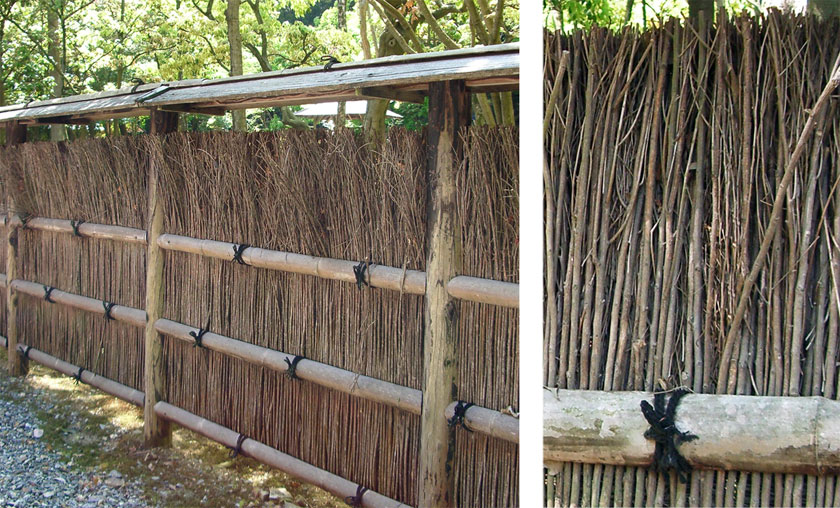|
||
 |
||

Shuuentei
聚遠亭 (Hyougo)
(C)2001 Japanese Architecture and Art Net Users System. No reproduction or republication without written permission.
掲載のテキスト・写真・イラストなど、全てのコンテンツの無断複製・転載を禁じます。
|
||||||
| shibagaki 柴垣 | ||||||
| KEY WORD : architecture / gardens | ||||||
| Also read shibakaki. A very old type of brushwood fencing, originally called fushigaki 布斯垣. Many references to brushwood fences can be found in the KOJIKI 古事記, the GENJI MONOGATARI 源氏物語 (The Tale of Genji) and the ISHIYAMADERA ENGI 石山寺縁起. The fences were made of any flexible brush or twigs gathered from fields and mountains, and twisted together, placed vertically on each side of horizontal strips of wood or bamboo and tied, usually with wisteria vine. To strengthen a long fence, young, slender, straight trunks of trees were also set among the brushwood. Shibagaki were widely used along with sukiya style architecture *sukiya-zukuri 数奇屋造. Three types were common: koshibagaki 小柴垣, a low brushwood fence; aoshibagaki 青柴垣, made of freshly cut brush that temporarily retained its green leafy appearance; and *uguisugaki 鴬垣 (nightingale fence), made only with the branches of spicebush, kuromoji 黒文字. Uguisugaki was about 1m high and used to partition areas of a garden. The horizontal strips were made of fairly large bamboo. The branches of spicebush were tied with rope and knotted decoratively. This type of fence is still used today for tea ceremony gardens. | ||||||
 Shuuentei
聚遠亭 (Hyougo)
|
||||||
| REFERENCES: | ||||||
| EXTERNAL LINKS: | ||||||
| NOTES: | ||||||
(C)2001 Japanese Architecture and Art Net Users System. No reproduction or republication without written permission. 掲載のテキスト・写真・イラストなど、全てのコンテンツの無断複製・転載を禁じます。 |
||||||